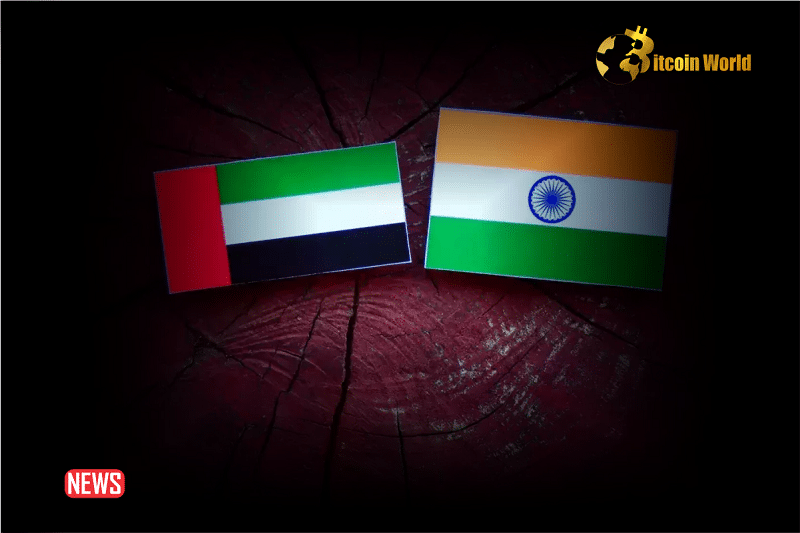Is the world witnessing a seismic shift in how global trade is conducted? Buckle up, because India and the United Arab Emirates (UAE) just made history, and it could be a game-changer! They’ve successfully completed their first-ever oil trade using the Indian rupee, bypassing the long-reigning US dollar. This isn’t just a minor transaction; it’s a bold statement signaling a potential move away from dollar dominance in international commerce. Let’s dive into why this is significant and what it means for the future of global finance.
What’s the Big Deal About Trading Oil in Rupees?
For decades, the US dollar has been the undisputed king of global trade, especially when it comes to commodities like oil. Most international transactions are priced and settled in dollars. But this India-UAE deal throws a wrench in the works, suggesting a growing appetite to explore alternatives. Why is this happening, and why now?
- De-dollarization on the Rise: The move is a clear indicator of ‘de-dollarization’ – a trend where countries seek to reduce their reliance on the US dollar for trade and reserves.
- BRICS Influence: Both India and the UAE are closely linked to the BRICS economic alliance (Brazil, Russia, India, China, and South Africa). BRICS has been vocal about decreasing Western financial influence and promoting the use of local currencies in trade.
- Economic Independence: Trading in rupees allows India and UAE to reduce their dependence on dollar exchange rates and potentially lower transaction costs.
De-Dollarization Efforts Bear Fruit: The India-UAE Example
Throughout 2023, the BRICS nations have been actively pushing for a more multi-polar financial system. Reducing reliance on the US dollar is a key pillar of this strategy. The India-UAE oil trade deal is a tangible outcome of these efforts. Let’s break down why this particular transaction is so noteworthy:
- First of its Kind: This is the first time India and UAE have settled an oil trade in rupees, marking a significant departure from traditional dollar-based transactions.
- Substantial Trade: This wasn’t a small token trade. It was part of India’s massive $157.5 billion oil import bill, demonstrating the potential scale of rupee-based trade.
- RBI’s Push: The Reserve Bank of India (RBI) has been proactive in promoting rupee trade. In 2022, they introduced mechanisms to facilitate import and export settlements in rupees.
See Also: BRICS Won’t Succeed In Killing The Dollar: Bank Of America
This move isn’t just about economics; it’s also about geopolitical strategy. By using the rupee, India and UAE are:
- Strengthening Bilateral Ties: It fosters closer economic cooperation and strengthens the partnership between the two nations.
- Promoting Rupee’s Global Role: This trade elevates the rupee’s status as a currency for international settlements.
- UAE’s BRICS Entry: With the UAE set to join BRICS in 2024, this rupee trade could be a precursor to deeper financial integration within the alliance.
A Global Paradigm Shift: Are We Seeing the End of Dollar Dominance?
The India-UAE oil deal in rupees raises a crucial question: Is this the beginning of a larger global shift away from the US dollar? While it’s too early to declare the dollar’s reign over, this development is undoubtedly significant. Here’s why:
- Setting a Precedent: This agreement could encourage other nations to explore similar arrangements, especially within the BRICS and developing economies.
- Challenging Dollar Hegemony: It’s a clear signal that nations are actively seeking alternatives to the dollar, reflecting a desire for a more balanced global financial system.
- Multi-polar World Order: This move aligns with the broader trend of a multi-polar world, where economic and political power is distributed among multiple nations, rather than concentrated in a single superpower.
See Also: Five Countries Set To Join BRICS Next Month
However, it’s important to maintain a balanced perspective. The US dollar still holds immense sway in global finance due to its liquidity, stability, and widespread use. Completely displacing it is a monumental task. Yet, the India-UAE deal highlights a clear trend – nations are increasingly seeking diversification and alternatives.
Key Takeaways:
- Historic Milestone: India and UAE’s rupee-based oil trade is a landmark event in de-dollarization efforts.
- BRICS Influence is Real: This deal underscores the growing economic and political influence of the BRICS alliance.
- Rupee on the Rise: The Indian rupee is gaining prominence as a currency for international trade settlements.
- Geopolitical Implications: This shift reflects a changing global power balance and the rise of multi-polarism.
Looking Ahead: What’s Next?
The India-UAE rupee oil trade is more than just a transaction; it’s a symbol of evolving global dynamics. As more countries explore alternatives to the US dollar, we can expect to see:
- Increased Bilateral Currency Agreements: More nations might enter into agreements to trade in their local currencies.
- Growth of Alternative Financial Systems: BRICS and other blocs may further develop their own financial infrastructure to facilitate trade outside the dollar system.
- Gradual Shift, Not a Revolution: De-dollarization is likely to be a gradual process, not an overnight upheaval. The dollar’s dominance won’t vanish immediately, but its influence may slowly erode over time.
In Conclusion:
The India-UAE oil trade in rupees is a pivotal moment. It’s a testament to the growing momentum behind de-dollarization and the increasing assertiveness of emerging economies like India and the UAE in shaping the future of global commerce. While the dollar’s global role isn’t ending today, this landmark agreement signals a significant shift and a step towards a more multi-polar and potentially less dollar-centric world. Keep watching this space – the global financial landscape is changing, and this is just the beginning!
Disclaimer: The information provided is not trading advice, Bitcoinworld.co.in holds no liability for any investments made based on the information provided on this page. We strongly recommend independent research and/or consultation with a qualified professional before making any investment decisions.


